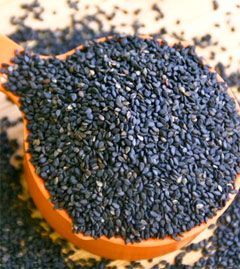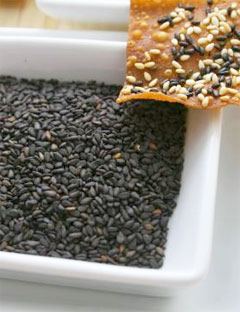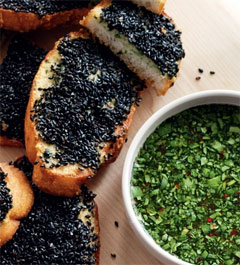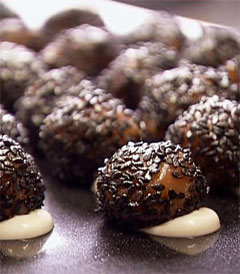|
|
Black Sesame Seeds: Ancient Women Source to Prolong Youth and Beauty

Women of ancient Babylon would eat halva, a mixture of honey and sesame
seeds to prolong youth and beauty, while Roman soldiers ate the mixture for
strength and energy.
For thousands of years, sesame seeds have been a source of food and oil. Sesame
has one of the highest oil content of any seed, some varietals exceeding 50 per
cent oil content compared to soybean's 20 per cent. Sesame oil is one of the
most stable vegetable oils, with long shelf life, because of the high level of
natural antioxidants (sesamin, sesamolin, and sesamol). Oil from the seed is
used in cooking, as salad oils and margarine, and contains about 47 per cent
oleic and 39 per cent linoleic acid. Sesame seed oil, like sunflower seed oil,
is rich in Omega 6 fatty acids, but lacks Omega 3 fatty acids. Sesame seed is
also rich in protein, at 25 per cent by weight. The flour that remains after oil
extraction is between 35 to 50 per cent protein, has good effective
carbohydrates, and contains water-soluble antioxidants (sesaminol glucosides)
that provide added shelf-life to many products. This flour, also called sesame
meal, is an excellent high-protein feed for poultry and livestock. The addition
of sesame to high lysine meal of soybean produces a well balanced animal feed.
The relative ratio of protein and oil, as well as essential amino acids and
essential fatty acids varies with sesame cultivar as well as growing conditions.
In 2008, about 65 percent of the annual sesame crop was processed into oil and
35 per cent was used in food. The food segment included about 42 per cent
roasted sesame, 36 per cent washed sesame, 12 per cent ground sesame and 10 per
cent roasted sesame seed with salt.
Kamal-Eldin et al. have reviewed patent literature claiming beneficial effects
of sesame seed. They note that these health claims are based on the very high
levels (up to 2.5%) of furofuran lignans with beneficial physiological
activities, mainly sesamin, sesamolin, and sesaminol glucosides. Among edible
oils from six plants, sesame oil had the highest Ferric Reducing/Antioxidant
Power (FRAP) value, which means the herbs and additives are better preserved in
sesame oil. To the extent these herbs have health benefits, the study proposes
that it may be possible that ingestion of these herbs preserved in sesame oil
could increase resistance of polyunsaturated fatty acids of cell membranes and
lipoproteins to oxidation within the body.
Sesame seeds contain the lignans pinoresinol and lariciresinol.
Sesame is a flowering plant in the genus Sesamum. Numerous wild relatives occur
in Africa and a smaller number in India. It is widely naturalized in tropical
regions around the world and is cultivated for its edible seeds, which grow in
pods. Sesame seed is considered to be the oldest oilseed crop known,
domesticated well over 3000 years ago. Sesame is very drought-tolerant. It has
been called a survivor crop, with an ability to grow where most crops fail.
Sesame has one of the highest oil contents of any seed. With a rich nutty
flavour, it is a common ingredient in cuisines across the world. Sesame, like
other nuts and foods, can trigger allergic reactions in some people. The world
harvested about 3.84 million metric tonnes of sesame seeds in 2010. The largest
producer of sesame seeds in 2010 was Burma. The world's largest exporter of
sesame seeds was India, and Japan the largest importer.
Sesame seeds a very good source of manganese and copper, but they are also a
good source of calcium, magnesium, iron, phosphorus, vitamin B1, zinc and
dietary fibre. In addition to these important nutrients, sesame seeds contain
two unique substances: sesamin and sesamolin. Both of these substances belong to
a group of special beneficial fibres called lignans, and have been shown to have
a cholesterol-lowering effect in humans, and to prevent high blood pressure and
increase vitamin E supplies in animals. Sesamin has also been found to protect
the liver from oxidative damage.
Sesame Seeds Nutritional Profile
 In a 1 ounce (28g) serving of sesame seeds. In a 1 ounce (28g) serving of sesame seeds.
-
Manganese � 0.7 mg. 35% RDA.
-
Copper � 0.7 mg. 35% RDA.
-
Calcium � 277 mg. 28% RDA.
-
Iron � 4.1 mg. 23% RDA.
-
Magnesium � 99.7 mg. 25% RDA.
-
Tryptophan � 93 mg.
-
Zinc � 2 mg. 13% RDA.
-
Fiber � 3.9 g. 16% RDA.
-
Thiamin � 0.2 mg. 15% RDA.
-
Vitamin B6 � 0.2 mg. 11% RDA.
-
Phosphorous � 179 mg. 18% RDA.
-
Protein � 4.7 g.
Health Benefits of Sesame Seeds
Promote Healthy, Beautiful Skin � Sesame seeds are full of zinc, an
essential mineral for producing collagen and giving skin more elasticity. Zinc
also helps damaged tissues in the body to repair. Sesame oil is also known to
sooth burns and prevent skin related disorders.
Great for High-Protein Vegetarian Diet � Sesame seeds offer 4.7 grams of protein
per ounce, giving them a perfect place in a high-protein vegetarian diet.
Sesame Seed Oil for Oral Health � One of the most prominent benefits of sesame
seeds and sesame oil revolves around removing dental plaque and boosting oral
health. By engaging in an activity known as oil pulling, which involves swishing
oil around in your mouth, you can boost oral health and even whiten your teeth.
One study showcases the oil pulling benefits on the oral level, where oil
pulling with sesame oil was shown to reduce the amount of streptococcus mutants
in both teeth plaque and mouth saliva, and boost
overall health.
Helps Prevent Diabetes � Thanks to magnesium and other nutrients, sesame seeds,
and especially sesame oil, has been shown to combat diabetes. One study,
published in 2011 in the Clinical Journal of Nutrition, found that sesame oil
�improved the effectiveness of the oral antidiabetic drug glibenclamide in type
2 diabetic patients�. Another study concluded that �substitution of sesame oil
as the sole edible oil has an additive effect in further lowering BP and plasma
glucose in hypertensive diabetics�.
Reduces Blood Pressure � As the above study concludes, sesame oil has been shown
to lower blood pressure in hypertensive diabetics. Additionally, magnesium has
been shown to help lower blood pressure � and sesame seeds are loaded with
magnesium.
Promotes Heart Health - Further adding to the health benefits of sesame seeds,
sesame seed oil can boost heart health by preventing atherosclerotic lesions. An
antioxidant and anti-inflammatory compound known as sesamol, which also
harnesses anti-atherogenic properties, is thought to be one reason for the
beneficial effects. According to GreenMedInfo, sesamol has been shown to
�possess over two dozen beneficial pharmacologically active properties, many of
which may contribute to improving cardiovascular health�.
 Protects Against DNA Damage from Radiation - Sesamol, a compound found in sesame
seeds and sesame oil, has been shown in some studies to protect against DNA
damaged caused by radiation. Further, sesamol has been shown to extend life in
mice treated with radiation, partly by preventing damage to the intestines and
the spleen. Protects Against DNA Damage from Radiation - Sesamol, a compound found in sesame
seeds and sesame oil, has been shown in some studies to protect against DNA
damaged caused by radiation. Further, sesamol has been shown to extend life in
mice treated with radiation, partly by preventing damage to the intestines and
the spleen.
Prevents Cancer � Not only do sesame seeds contain an anti-cancer compound
called phytate, but the magnesium in sesame seeds also harness anti-cancer
properties. One study published in the American Journal of Clinical Nutrition
found that the risk of colorectal tumours decreased by 13% and the risk of
colorectal cancer decreased by 12% for every 100 mg of magnesium taken in.
Boosts Bone Health - In addition to promoting healthy skin, zinc has also been
shown to boost bone mineral density and bone health as a whole. One study,
published in the American Journal of Clinical Nutrition, found a correlation
between zinc deficiency and osteoporosis in the hip and spine area. What�s more,
sesame seeds are a great source of calcium � a known trace mineral that is
essential for bone health and preventing related conditions.
Boosting Digestive Health, Relieving Constipation � Sesame seeds are rich in
fibre, which is known to pave way for a healthy digestive system and a healthy
colon.
Provides Relief from Rheumatoid Arthritis � A mineral that is important for
anti-inflammatory and antioxidant enzyme systems, copper is known for reducing
pain and swelling associated with arthritis. Additionally, this mineral helps
provide strength to blood vessels, bones, and joints.
Promotes Respiratory Health, Prevents Asthma � Thanks to the magnesium, sesame
seeds are able to prevent asthma by and other respiratory disorders by
preventing airway spasms.
Benefits of Black Sesame Seed: Traditional Chinese Herbal formulas
Black Sesame Seed properties benefit the Liver and Kidney Channels and can be
used to help in the treatment of disorders of these channels.
i) Benefits to Liver & Eyes
Black Sesame Seed can tonify or increase Liver Blood and nourish the eyes. These
therapeutic effects can assist in clearing blurred vision and tired, dry eyes
while you receive treatment.
ii) Nourish & Balance Organs
Many Traditional Chinese Herbal Medicine books mention Black Sesame Seed is very
good for the middle and older age group. It can increase energy, tonify the
brain and slow aging. Regularly eating certain amounts of Black Sesame Seed can
help to reduce and prevent the following symptoms: low back ache, painful or
tight and stiff joints, weakness in the joints and constipation.
iii) Beauty, Hair & Skin
Hair loss and dry skin is quite often a worry for people every day. Often people
spend a lot of money on hair and skin products which never completely solve the
problem. Chinese Medicine considers the hair and skin to be an external example
of the body�s internal state of health. For example, the hair is nourished by
the Blood and the skin receives moisture from the body�s Yin. When the Yin and
the Blood are deficient, it will affect the hair and the skin. It may cause hair
loss, dry skin or itchy skin.
Black Sesame Seed can nourish the organs, the Blood and the Yin, bringing Blood
and nutrition to the hair and skin. While using the lotions and creams and
having treatment, regularly eating a certain amount Black Sesame Seed will help
resolve the cause of the problem.
 Black sesame seeds has more calcium than any food. The only other food that has
more calcium is the top of the turnip which does not taste nice. So if you want
calcium, black sesame is the food to eat. Black sesame is a great jing tonic to
boost the endocrine system. heart and for the skin. It is a good building block
for muscle. It is one of the only food that can regrow a person�s hair from grey
to black. Black sesame seeds has more calcium than any food. The only other food that has
more calcium is the top of the turnip which does not taste nice. So if you want
calcium, black sesame is the food to eat. Black sesame is a great jing tonic to
boost the endocrine system. heart and for the skin. It is a good building block
for muscle. It is one of the only food that can regrow a person�s hair from grey
to black.
iv) Combat ageing
In traditional Chinese medicine (TCM), black sesame seeds are prized for their
ability to combat ageing and fight illnesses associated with old age, said Dr
Hong Hai, a TCM physician at Renhai Clinic and Public Free Clinic.
v) Recovery from illness
Black sesame seeds have been used to help patients recover from serious
illnesses and fevers. The seeds replenish the body of essential minerals lost
during illness. As well as assisting in recovery, black sesame seeds may be used
to help prevent illness by reducing cholesterol. The seeds contain phytosterol,
which is a compound similar to cholesterol but actually reduces it in the body.
Allergic Reactions to Sesame Seeds
On a global basis, and especially in countries like Canada, Japan and
Israel, the past 10 years have been characterized by increased prevalence of
sesame seed allergy.
Researchers believe that the increasingly common occurrence of sesame
allergy may be related to three important factors. One factor is the
increasingly widespread use of sesame oil and sesame seed components in food and
cosmetic products. Sesame oil has become an increasingly common component in
skin and massage oils and can also be found in hair care products, cosmetics,
perfumes, soaps, topical oils, and sunscreens. Within the food supply, sesame
oil can often be found in cookies, crackers, pastries, dips and spreads, soy
burgers, tempeh, granola bars, and other foods. Tahini is a butter made from
sesame seed. Gomasio is a sesame-based salt. Halvah is a sweet dessert often
made using sesame paste. On a product label, you should suspect the presence of
sesame whenever you see any of the following descriptions: sesamol, sesamolina,
tahini, tahina, gingelly oil, til oil, or benniseed.
A second important factor may be cross-reactivity. While not fully conclusive,
research in this area suggests that individuals with food allergy to peanuts,
walnuts, hazelnuts, or cashews may also experience allergic response to sesame
seeds. This allergic response is likely to involve proteins like Ses i 6 or Ses
i 7 that are found not only in sesame seeds but also in the other foods listed
above. Alternatively, the allergic response to sesame seeds may be related to
proteins like oleosins (which are storage proteins found in a wider variety of
nuts and seeds).
A final important factor may be processing-related contamination. Foods not
expected to contain any sesame seed components may end up containing these
components through shared equipment at food processing facilities or through
accidental contact during storage and transit (for example, rotation of nut and
seed products in bulk storage bins).
In the United States, beginning in 2004 with the passage of the Food Allergen
Labeling and Consumer Protection Act (FALCPA), food labels have been required to
identify the presence of any major food allergens. Since 90% of food allergies
in the U.S. have been associated with 8 food types as reported by the U.S.
Centers for Disease Control, it is these 8 food types that are considered to be
major food allergens in the U.S. and require identification on food labels. The
8 food types classified as major allergens are as follows:
(1) wheat, (2) cow's milk, (3) hen's eggs, (4) fish, (5) crustacean
shellfish (including shrimp, prawns, lobster and crab); (6) tree nuts (including
cashews, almonds, walnuts, pecans, pistachios, Brazil nuts, hazelnuts, and
chestnuts); (7) peanuts; and (8) soy foods. In the case of sesame seeds, in
addition to the concerns raised above, there is also some evidence showing
cross-reactivity with peanuts, walnuts, and cashews such that persons suspecting
food allergy to sesame seeds may also want to determine the dietary safety and
appropriateness of these other foods.
Sesame Seeds and Oxalates
The hulls of sesame seeds contain oxalates. In fact, most of the calcium
found in the seed hull comes in the form of calcium oxalate. The sesame seed
paste (tahini) found in grocery stores is most often made with seed
kernels�?"the part of the sesame seed that remains after the hull has been
removed. These products would generally be safe in moderate amounts on an
oxalate-restricted diet. However, products containing the seed hulls might have
more oxalates than desired on a low oxalate meal plan. Product labels do not
always indicate whether the hulls have been removed or not. For this reason,
check the colour of the tahini carefully and also inquire as to its taste. Most
sesame seed butters made from whole, non-hulled seeds are fairly dark in colour
and have a much more bitter taste than butters made from hulled sesame kernels.
In a study in the Journal of Agricultural and Food Chemistry, researchers
published the amounts of phytosterols present in nuts and seeds commonly eaten
in the United States.
Sesame seeds had the highest total phytosterol content (400-413 mg per 100
grams), and English walnuts and Brazil nuts the lowest (113 mg/100grams and 95
mg/100 grams). (100 grams is equivalent to 3.5 ounces.) Of the nuts and seeds
typically consumed as snack foods, pistachios and sunflower seeds were richest
in phytosterols (270-289 mg/100 g), followed by pumpkin seeds (265 mg/100 g).
Dated 22 August 201313
|
|
|
|
|









